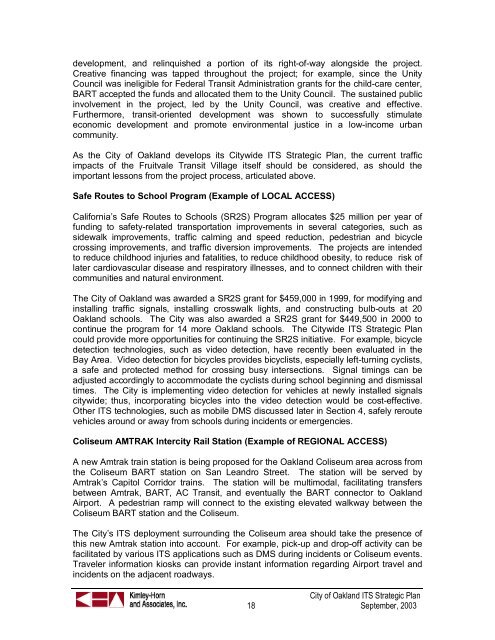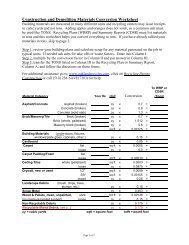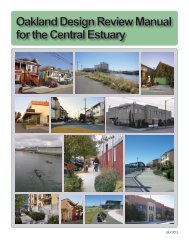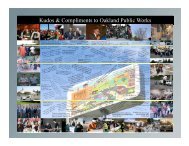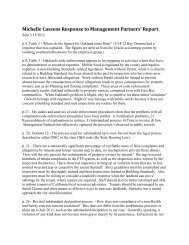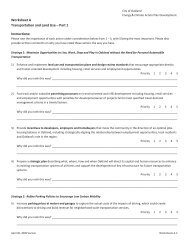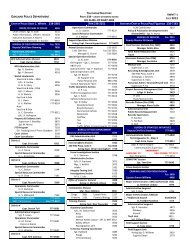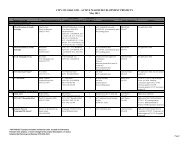Intelligent Transportation Systems - City of Oakland
Intelligent Transportation Systems - City of Oakland
Intelligent Transportation Systems - City of Oakland
You also want an ePaper? Increase the reach of your titles
YUMPU automatically turns print PDFs into web optimized ePapers that Google loves.
development, and relinquished a portion <strong>of</strong> its right-<strong>of</strong>-way alongside the project.<br />
Creative financing was tapped throughout the project; for example, since the Unity<br />
Council was ineligible for Federal Transit Administration grants for the child-care center,<br />
BART accepted the funds and allocated them to the Unity Council. The sustained public<br />
involvement in the project, led by the Unity Council, was creative and effective.<br />
Furthermore, transit-oriented development was shown to successfully stimulate<br />
economic development and promote environmental justice in a low-income urban<br />
community.<br />
As the <strong>City</strong> <strong>of</strong> <strong>Oakland</strong> develops its <strong>City</strong>wide ITS Strategic Plan, the current traffic<br />
impacts <strong>of</strong> the Fruitvale Transit Village itself should be considered, as should the<br />
important lessons from the project process, articulated above.<br />
Safe Routes to School Program (Example <strong>of</strong> LOCAL ACCESS)<br />
California’s Safe Routes to Schools (SR2S) Program allocates $25 million per year <strong>of</strong><br />
funding to safety-related transportation improvements in several categories, such as<br />
sidewalk improvements, traffic calming and speed reduction, pedestrian and bicycle<br />
crossing improvements, and traffic diversion improvements. The projects are intended<br />
to reduce childhood injuries and fatalities, to reduce childhood obesity, to reduce risk <strong>of</strong><br />
later cardiovascular disease and respiratory illnesses, and to connect children with their<br />
communities and natural environment.<br />
The <strong>City</strong> <strong>of</strong> <strong>Oakland</strong> was awarded a SR2S grant for $459,000 in 1999, for modifying and<br />
installing traffic signals, installing crosswalk lights, and constructing bulb-outs at 20<br />
<strong>Oakland</strong> schools. The <strong>City</strong> was also awarded a SR2S grant for $449,500 in 2000 to<br />
continue the program for 14 more <strong>Oakland</strong> schools. The <strong>City</strong>wide ITS Strategic Plan<br />
could provide more opportunities for continuing the SR2S initiative. For example, bicycle<br />
detection technologies, such as video detection, have recently been evaluated in the<br />
Bay Area. Video detection for bicycles provides bicyclists, especially left-turning cyclists,<br />
a safe and protected method for crossing busy intersections. Signal timings can be<br />
adjusted accordingly to accommodate the cyclists during school beginning and dismissal<br />
times. The <strong>City</strong> is implementing video detection for vehicles at newly installed signals<br />
citywide; thus, incorporating bicycles into the video detection would be cost-effective.<br />
Other ITS technologies, such as mobile DMS discussed later in Section 4, safely reroute<br />
vehicles around or away from schools during incidents or emergencies.<br />
Coliseum AMTRAK Intercity Rail Station (Example <strong>of</strong> REGIONAL ACCESS)<br />
A new Amtrak train station is being proposed for the <strong>Oakland</strong> Coliseum area across from<br />
the Coliseum BART station on San Leandro Street. The station will be served by<br />
Amtrak’s Capitol Corridor trains. The station will be multimodal, facilitating transfers<br />
between Amtrak, BART, AC Transit, and eventually the BART connector to <strong>Oakland</strong><br />
Airport. A pedestrian ramp will connect to the existing elevated walkway between the<br />
Coliseum BART station and the Coliseum.<br />
The <strong>City</strong>’s ITS deployment surrounding the Coliseum area should take the presence <strong>of</strong><br />
this new Amtrak station into account. For example, pick-up and drop-<strong>of</strong>f activity can be<br />
facilitated by various ITS applications such as DMS during incidents or Coliseum events.<br />
Traveler information kiosks can provide instant information regarding Airport travel and<br />
incidents on the adjacent roadways.<br />
<strong>City</strong> <strong>of</strong> <strong>Oakland</strong> ITS Strategic Plan<br />
18 September, 2003


